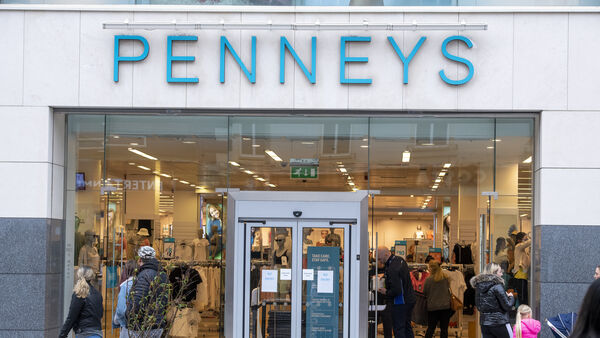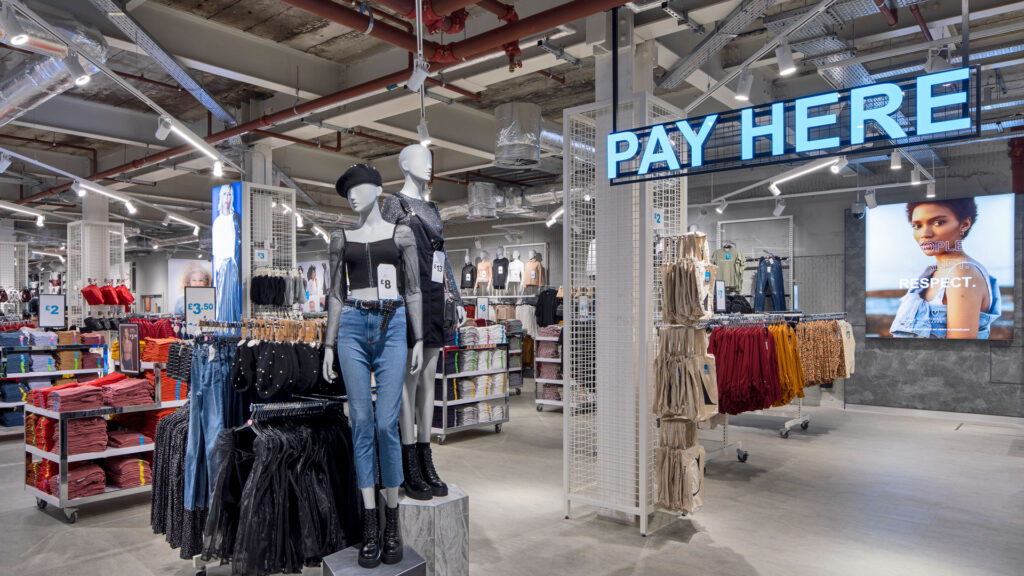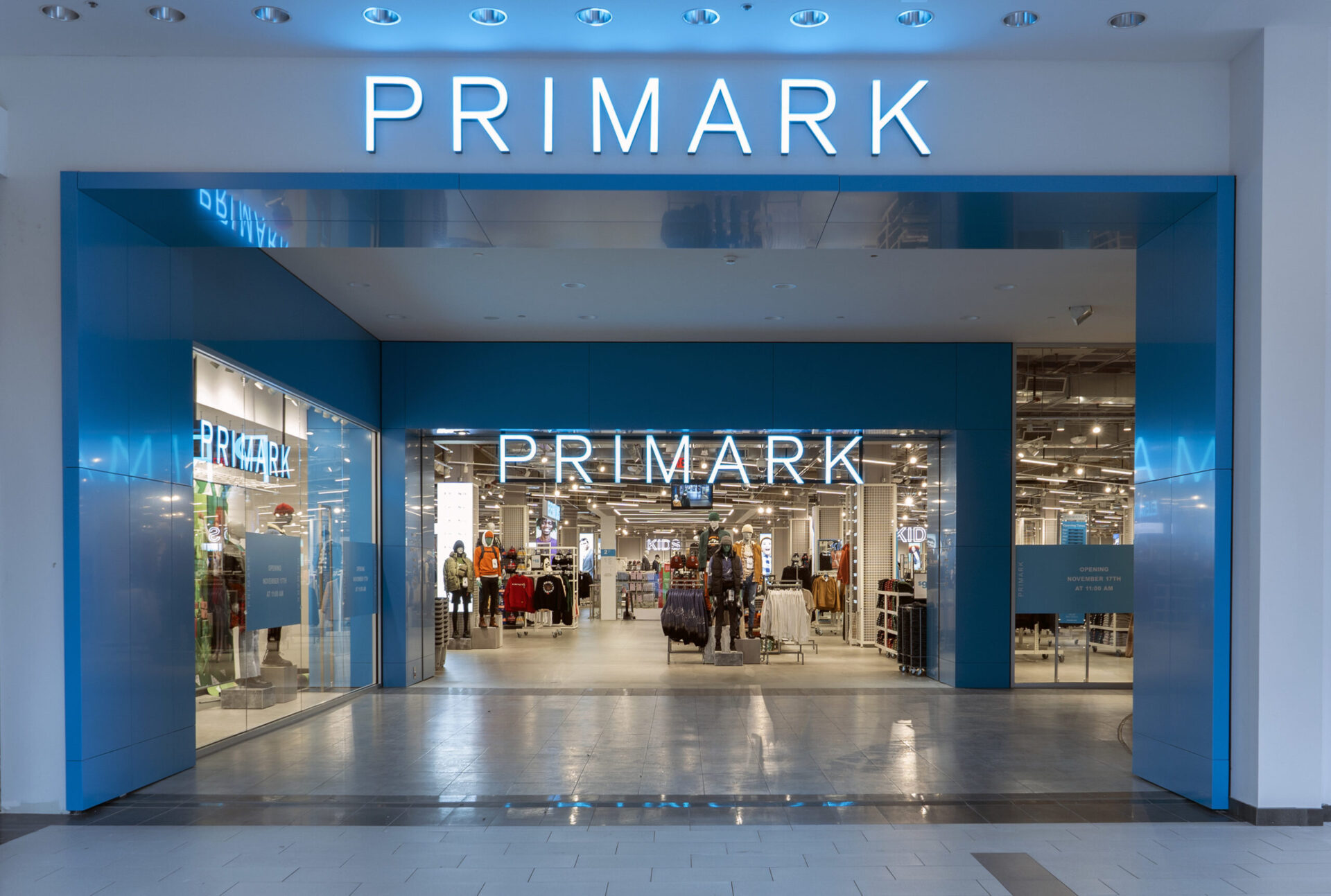Primark, a prominent name in the fast-fashion retail sector, has captivated the world with its trendy and affordable clothing offerings. With its origins tracing back to Dublin, Ireland, Primark has evolved into an international fashion powerhouse with a vast network of stores across various continents. Known for its budget-friendly prices and a wide range of stylish clothing, accessories, and home goods, Primark has become a go-to destination for fashion-forward shoppers seeking the latest trends without breaking the bank.
Primark is an international fast fashion retailer headquartered in Dublin, Ireland. The company was founded in 1969 by Arthur Ryan and is now one of the largest clothing retailers in the world. Primark has over 400 stores in 15 countries, including the United Kingdom, Ireland, Spain, Portugal, Germany, the Netherlands, Belgium, France, Italy, Austria, Poland, and the United States.

Primark’s commitment to delivering the latest runway-inspired styles at affordable prices sets it apart in the competitive retail landscape. The brand’s extensive product range encompasses clothing for all seasons, from stylish everyday wear to beachwear, activewear, and formal attire. Alongside its fashion collections, Primark offers an array of accessories, footwear, beauty products, and homeware items, catering to various lifestyle needs.
Primark’s business model is based on selling high-volume, low-margin products. The company is able to keep its prices low by sourcing its products from low-cost countries and by keeping its overhead costs down. Primark also benefits from its large scale, which allows it to negotiate better deals with suppliers.
Founding History of Primark
The founding history of Primark can be traced back to 1969 when Arthur Ryan, an Irish entrepreneur, established the first Primark store under the name “Penneys” in Mary Street, Dublin, Ireland. The store was situated in a prime shopping location and introduced a revolutionary concept to the retail industry: offering fashionable clothing at affordable prices. This novel approach quickly garnered attention and set the stage for Primark’s rapid expansion and eventual global success.
The name “Penneys” was derived from the idea of offering quality products at a price that would appeal to penny-conscious consumers. The store’s initial focus was on providing the latest fashion trends at prices significantly lower than those of competitors, making stylish clothing accessible to a broader demographic.

The strategy proved to be immensely popular, leading to the opening of more Penneys stores across Ireland. The brand’s offerings resonated with consumers who were looking for affordable and on-trend clothing options. Within a few years, Penneys had firmly established itself as a leading fashion retailer in Ireland, attracting a loyal customer base and gaining recognition for its exceptional value for money.
In the 1970s, Primark made a strategic move to expand beyond Ireland’s borders and entered the UK market. The first UK store was opened in Derby in 1973, and the brand quickly gained traction with British consumers. The expansion continued at a steady pace, with new stores popping up across major cities in the UK.
By the 1980s, Primark had become a well-known high-street fashion retailer, and its success prompted further international expansion. The brand ventured into Spain in 2006, opening its first store in Madrid. The positive response from Spanish shoppers encouraged Primark to explore new markets across Europe. In subsequent years, Primark established a significant presence in countries like Portugal, France, Germany, Italy, and the Netherlands.
With the 2010s came expansion outside Europe, with the brand setting foot in the United States, making its debut in Boston, Massachusetts, in 2015. The US market proved to be receptive to Primark’s offerings, leading to the opening of several stores across the country in subsequent years.
Today, Primark continues to grow its global footprint, with stores in various countries across Europe, North America, and even as far as the Middle East. The brand’s reputation for offering affordable, stylish, and on-trend clothing remains unwavering, making it a go-to destination for fashion-conscious consumers seeking value without compromising on style.
Marketing Strategies of Primark
Primark employs a range of marketing strategies to position itself as a leading fast-fashion retailer and maintain its strong brand presence in the competitive fashion industry. Let’s explore these marketing strategies in detail:
Affordable Pricing:
Affordable pricing is one of the key marketing strategies employed by Primark, which has helped the fast fashion giant gain popularity among consumers around the globe. Here’s how affordable pricing works as a marketing strategy for Primark:
Attract Wide Range of Customers: Primark targets various demographics by offering low prices that cater to different income levels and budgets. Its competitive pricing structure makes the brand accessible to people who might otherwise avoid higher-priced clothing options due to financial constraints. This broadens Primark’s potential customer base significantly, attracting shoppers from diverse socioeconomic backgrounds.
Encourages Frequent Purchases: Low prices entice customers to make more frequent purchases since they perceive less risk when buying items that cost less money. As a result, Primark benefits from increased sales volume due to repeat business from satisfied customers looking for good value and trendy styles at budget-friendly rates.
Competition Advantage: Primark leverages its affordable pricing to differentiate itself from premium or mid-range apparel brands. Offering lower costs than many competitors positions Primark favorably in terms of price comparison and perceived worth. This advantage helps draw customers who want similar styles but are unwilling or unable to pay higher prices elsewhere.
Promotions and Sales: To drive sales and clear inventory, Primark frequently runs promotions and discounts that appeal to bargain hunters. These campaigns not only boost revenue but also reinforce the brand’s reputation for being wallet-friendly. Regular sales and special offers keep customers coming back for more, knowing they can find great deals on the latest fashion trends without breaking the bank. This consistent stream of promotions and sales keeps Primark top-of-mind for budget-conscious shoppers searching for stylish wardrobe additions at reasonable prices.
Overall, Primark’s affordable pricing strategy effectively expands its customer base, encourages repeat business through frequent purchases, sets the brand apart from competitors, and drives sales via promotions and discounts. By making fashion accessible to all, Primark fosters a sense of inclusiveness and remains relevant in today’s economy where value matters just as much as style.
Extensive Product Range:
Another primary marketing strategy used by Primark is having an extensive product range across multiple categories. Here’s how this approach works as a marketing strategy for the brand:
Appeals to Variety Seekers: Offering a wide selection of merchandise caters to individuals who enjoy exploring different styles and trying out new looks. With such a vast array of choices available within each category (such as women’s wear, men’s wear, children’s clothes, homeware, beauty products), Primark satisfies the needs of those who prefer browsing numerous options before making a decision.
Meets Diverse Needs: A comprehensive product line accommodates varying consumer requirements and lifestyles. For example, Primark provides seasonal attire suitable for different climates, occasions, and sizes, addressing the unique requirements of their clientele. Additionally, the brand’s offerings include essential household goods and wellness essentials, broadening its reach beyond just fashion.
Increased Foot Traffic: By carrying a substantial assortment of products, Primark attracts more visitors to its stores. Shoppers interested in finding specific items are likely to visit more often since they believe there’s a better chance of discovering what they need amidst the brand’s extensive catalog. Greater foot traffic increases opportunities for impulse purchases and serendipitous discoveries, potentially leading to additional sales.
Flexibility in Marketing Efforts: Having a versatile product mix enables Primark to tailor its advertising and promotion strategies according to current trends, seasons, or events. This adaptability allows the brand to remain responsive to changing consumer interests and capitalize on emerging opportunities for growth.
Cost Savings: Carrying a large variety of stock means Primark can negotiate better deals with suppliers due to larger order volumes. This results in reduced production costs, contributing to the brand’s ability to provide competitive pricing while still maintaining profit margins. Overall, Primark’s extensive product range serves as a crucial component of its marketing efforts by appealing to a wider audience, meeting diverse needs, increasing foot traffic, enabling flexible marketing initiatives, and reducing costs. This multi-faceted approach supports the brand’s mission to deliver quality, affordable fashion and household essentials to customers worldwide.
Trend-Focused Approach:
Primark employs a trend-focused approach as part of its marketing strategy to stay ahead of the curve in the fast-paced fashion industry. Here’s how this tactic contributes to the brand’s success:
Staying Relevant: By keeping up with popular styles and designs, Primark ensures it remains relevant among consumers seeking the latest fashion trends. The brand continuously updates its collections to reflect contemporary tastes, which resonates positively with younger demographics who prioritize remaining fashionable and on-trend.
Quick Adaptation: Primark’s nimble response to evolving fashion patterns allows them to swiftly introduce new lines or restock bestsellers. This agility permits the brand to capitalize on popular demand and maintain high levels of availability for sought-after pieces. Customers appreciate access to fresh, desirable items and feel confident that Primark will have what they desire.
Limited Edition Collections: Periodically introducing exclusive ranges further enhances Primark’s trend-focused approach. These limited edition releases create excitement around new arrivals and encourage shoppers to act quickly to secure their preferred pieces. This exclusivity generates buzz and creates a sense of urgency, driving sales and strengthening customer loyalty.
Collaborations and Partnerships: Another aspect of Primark’s trend-driven method involves collaborating with renowned designers, influencers, and cultural icons to develop capsule collections or special editions. Such partnerships generate interest and media attention, drawing attention to Primark’s innovative approaches and showcasing its commitment to providing cutting-edge fashion.
Social Media Presence: Maintaining an active social media presence plays a vital role in Primark’s trend-focused strategy. Sharing curated content featuring the latest fashion trends, new arrivals, and inspiring outfit combinations helps engage followers and keeps Primark top-of-mind for fashion-conscious audiences. Though Primark leverages user-generated content and influencer collaborations to amplify its message across various platforms. By embracing digital marketing tactics and utilizing social media to connect with customers where they spend most of their time online, Primark maximizes its impact and fosters a strong relationship between the brand and its target audience.
In summary, Primark’s trend-focused approach is a key element of its marketing strategy that helps keep the brand at the forefront of fashion trends, encourages quick adaptation to meet evolving consumer preferences, drives sales through limited edition collections and collaborations, and establishes a robust social media presence to remain top-of-mind among fashion-conscious consumers.
Large-Format Physical Stores:
Unlike many of its competitors, Primark primarily relies on brick-and-mortar stores as its main distribution channel. The brand’s large-format stores are strategically located in busy shopping districts and iconic retail destinations, attracting high foot traffic. These spacious stores allow Primark to display its extensive product range in visually appealing layouts, creating an immersive and enjoyable shopping experience for customers.
Primark adopts large-format physical stores as a marketing strategy to offer customers an immersive shopping experience and increase footfall. Here’s why this approach works well for the brand:
Immersive Experience: Large-scale stores allow Primark to create an interactive environment that fully captivates customers. Spacious layouts permit the display of ample inventory, making it easier for shoppers to explore and find what they want without feeling overwhelmed. The size also facilitates creative displays, eye-catching visual merchandising, and experiential elements like play areas or photo zones, all of which contribute to an enjoyable shopping journey.
Competitive Pricing Strategy: Offering low prices is central to Primark’s business model. Its large-format stores enable the brand to optimize operations and reduce expenses associated with running multiple locations. As a result, Primark can pass cost savings onto customers via competitive pricing, helping to draw in bargain hunters and value seekers who might otherwise shop elsewhere.
Attracting New Customers: The sheer scale of Primark’s stores acts as a magnet for first-time visitors curious about the brand or simply looking for a convenient one-stop destination for all their family’s clothing and homeware needs. Once inside, the welcoming ambiance and comprehensive selection make it easy for these potential clients to become regular customers.
Encouraging Cross-Selling: Large-format stores present Primark with the opportunity to cross-promote different categories within each location. For example, displaying apparel alongside related accessories or grouping homeware items together can drive incremental sales by showing customers complementary items they may not have considered separately.
Enhancing Brand Image: Primark’s decision to invest in spacious, modern stores communicates a positive image to customers and the public alike. It signals the brand’s confidence in its offering and commitment to providing a premium retail experience. In addition, Primark’s large-format stores often feature sustainable and energy-efficient designs, reflecting the company’s dedication to environmental responsibility and resonating positively with socially conscious customers. Overall, Primark’s focus on creating impressive physical spaces supports its goal of becoming a leading global fashion brand while catering to diverse customer segments seeking quality products at affordable prices.

Word-of-Mouth Marketing:
Primark benefits from strong word-of-mouth marketing, with satisfied customers often sharing their positive experiences and purchases with friends and family. The brand’s reputation for offering affordable and stylish fashion encourages loyal customers to advocate for the brand, driving new footfall and boosting sales.
Here are some ways Primark capitalizes on WOM marketing:
User-Generated Content Campaigns: Most mass market fashion retailers today would agree that e-commerce plays a vital role in guaranteeing success by fulfilling their customer’s demands. However, there is one Irish value fast-fashion chain which has managed to succeed in Europe without the aid of an online store, namely Penneys, better known as Primark.
Primark has managed to create an incredibly active online following known as ‘Primania’ without the aid of any e-commerce arm. It’s online platform invites customers from all over the world to share photos and images of their Primark outfits to Instagram with the hashtag #Primania, which are subsequently shown in its LED store displays across Europe and the US.
Referral Traffic Drived by Influencer Partnerships: Primark collaborates with popular influencers and micro-influencers to showcase its products in creative ways. When these individuals post pictures or videos featuring Primark clothes or home decor, their followers take notice and potentially visit Primark stores or websites, boosting referral traffic and expanding Primark’s reach.
Positive Online Reviews and Feedback: Primark actively monitors online reviews and feedback shared on platforms like Trustpilot or Google. The brand responds promptly to negative comments and uses positive ones to fuel social proof, demonstrating its commitment to excellent service and product quality. This proactive management of online reputation motivates happy customers to recommend Primark to others.
Limited Advertising:
One unique aspect of Primark’s marketing approach is its limited reliance on traditional forms of advertising compared to many fast-fashion rivals. Instead, Primark prioritizes alternative methods that align better with its target audience preferences and overall brand identity. Here are some reasons why Primark chooses this tactic:
Appealing to Young Demographics: Many young consumers, particularly those under 25 years old, tend to be less responsive to conventional adverts due to oversaturation and skepticism towards corporate messaging. Therefore, Primark concentrates on building emotional connections with shoppers through memorable store environments, interactive features, and exceptional customer experience rather than solely pushing promotions or price points.
Cost Savings: By reducing spend on expensive advertising campaigns, Primark allocates resources toward maintaining competitive pricing and supporting its large-scale expansion plans without sacrificing profitability. This balanced financial strategy helps ensure long-term viability and growth opportunities while still delivering value to customers.
Authenticity and Transparency: Avoiding overt commercialization allows Primark to project a genuine image and build trust among younger generations who favor brands perceived as authentic and transparent. This mindset aligns well with Primark’s emphasis on ethical sourcing practices and fair labor standards throughout its supply chain.
Emphasizing Social Media Presence: While Primark does allocate funds toward digital marketing efforts, its primary focus remains cultivating an engaged community through Instagram, Facebook, Twitter, TikTok, and Pinterest. By regularly posting captivating lifestyle imagery, fun challenges, and behind-the-scenes footage, Primark creates a vibrant online presence that resonates with Gen Z and Millennial audiences.
Overall, Primark’s minimalist advertising philosophy reflects its commitment to responsible spending, authentic communication, and meaningful engagement with its loyal clientele base.
Social Media Engagement:
Primark excels at using social media to connect with its target audience and drive sales by implementing several effective tactics. Here are five examples of how Primark utilizes social media for successful marketing purposes:
Interactive Content Creation: Primark frequently shares visually appealing images and short video clips that encourage users to interact with the brand via likes, comments, and shares. For instance, Primark often posts quirky questions or polls related to fashion trends or seasonal must-haves to spark discussion and increase engagement rates.
User-Generated Content (UGC) Amplification: Primark capitalizes on UGC by reposting photos and videos tagged #Primania or featuring Primark products. This not only enhances brand visibility but also strengthens the bond between customers and the brand by acknowledging and valuing their contributions.
Timely Promotions and Sales Announcements: To keep customers informed about current deals and discounts, Primark regularly updates its social media channels with flash sales, clearance items, and new arrival notifications. This approach keeps followers interested and eager to make purchases when they see attractive offers.
Behind-The-Scenes Access: Offering insights into Primark’s design process, manufacturing facilities, and employee life humanizes the brand and fosters a sense of familiarity with its audience. Sharing such content also highlights Primark’s dedication to sustainability and fair labor practices, further bolstering its reputation as a socially conscious retailer.
Cross-Platform Integration: Primark seamlessly integrates its social media presence across multiple platforms by sharing consistent visual elements, brand voice, and hashtags. This consistency helps establish a cohesive brand identity and increases discoverability for potential customers browsing different social media platforms.
Primark actively engages with its customers through various social media platforms, including Instagram, Facebook, Twitter, and YouTube. The brand shares visuals of its latest collections, fashion inspiration, and style tips, encouraging followers to engage and interact with the brand online.
Overall, Primark’s marketing strategies effectively position the brand as a go-to destination for affordable and on-trend fashion. By focusing on affordability, extensive product offerings, trend-consciousness, and a customer-centric shopping experience, Primark continues to attract a broad customer base and maintains its status as a leading player in the fast-fashion retail market.
Marketing Mix of Primark
The marketing mix, also known as the 4Ps (Product, Price, Place, and Promotion), is a crucial framework that helps companies like Primark create and implement effective marketing strategies. Let’s explore the marketing mix of Primark in detail:
Product:
Primark’s product range caters to various demographics and fashion preferences. For women, the brand offers a wide selection of dresses, tops, bottoms, outerwear, swimwear, and lingerie, encompassing casual, formal, and athleisure wear. Men can choose from a diverse array of shirts, t-shirts, trousers, jeans, jackets, and activewear. The children’s section features an extensive collection of clothing for infants, toddlers, and older kids, ensuring that the whole family can shop together.
In addition to apparel, Primark provides an array of accessories, including bags, scarves, hats, belts, and jewelry, allowing customers to complete their looks with fashionable extras. The brand also offers a selection of footwear, ranging from trendy sneakers to elegant heels and comfortable sandals.
Primark’s homeware department features bedding, home decor, kitchen essentials, and other lifestyle products, allowing customers to style their living spaces affordably.
Price:
Primark’s pricing strategy focuses on offering exceptional value for money. The brand adopts a cost-efficient supply chain, sourcing products directly from manufacturers and utilizing economies of scale to maintain competitive prices. By keeping operating costs low, Primark can pass on savings to customers, offering fashion products at significantly lower prices compared to many of its competitors.
The brand’s pricing appeals to a broad customer base, including students, young professionals, and families seeking affordable yet stylish clothing and accessories. Primark’s commitment to providing budget-friendly fashion has cemented its position as a go-to destination for cost-conscious consumers.
Place:
Primark strategically selects prime locations for its physical stores to attract maximum footfall and visibility. The brand’s stores are typically situated in bustling city centers, popular shopping malls, and high-traffic retail districts. Primark’s large-format stores offer a spacious and inviting shopping environment, providing ample space for customers to explore the vast product range.
The brand’s extensive global presence spans multiple countries in Europe, North America, and the Middle East, with plans for further expansion into new markets. Primark’s physical stores remain the primary touchpoint for customers to experience the brand’s fashion offerings and immerse themselves in the shopping experience.
Promotion:
While Primark relies less on traditional advertising, the brand leverages its visually appealing in-store displays and window merchandising as a powerful promotional tool. Eye-catching window setups and vibrant in-store presentations showcase the latest fashion trends, enticing passersby and drawing them into the stores.
Primark actively engages with its audience on various social media platforms. The brand’s Instagram account, in particular, serves as a hub for sharing fashion inspiration, new arrivals, style tips, and customer-generated content. Influencers and fashion bloggers frequently feature Primark products, amplifying the brand’s reach and relevance among its target audience.
Additionally, Primark occasionally collaborates with renowned designers or brands for limited-edition collections, generating excitement and buzz around exclusive collaborations. These collaborations not only boost brand visibility but also create a sense of exclusivity, encouraging customers to visit stores and make purchases during these special events.
Primark also emphasizes its sustainability initiatives and ethical practices in its promotional messaging, reinforcing its commitment to responsible sourcing and manufacturing.
Overall, Primark’s marketing mix revolves around offering affordable yet stylish products through its strategically located physical stores. The brand’s focus on value-driven pricing, on-trend fashion, engaging promotions, and social media presence enables it to remain relevant and appealing to a broad customer base, solidifying its position as a dominant player in the fast-fashion retail sector.
Also Read: Forever 21 Bankruptcy : Why and How did Forever 21 Fail?
To read more content like this, subscribe to our newsletter



